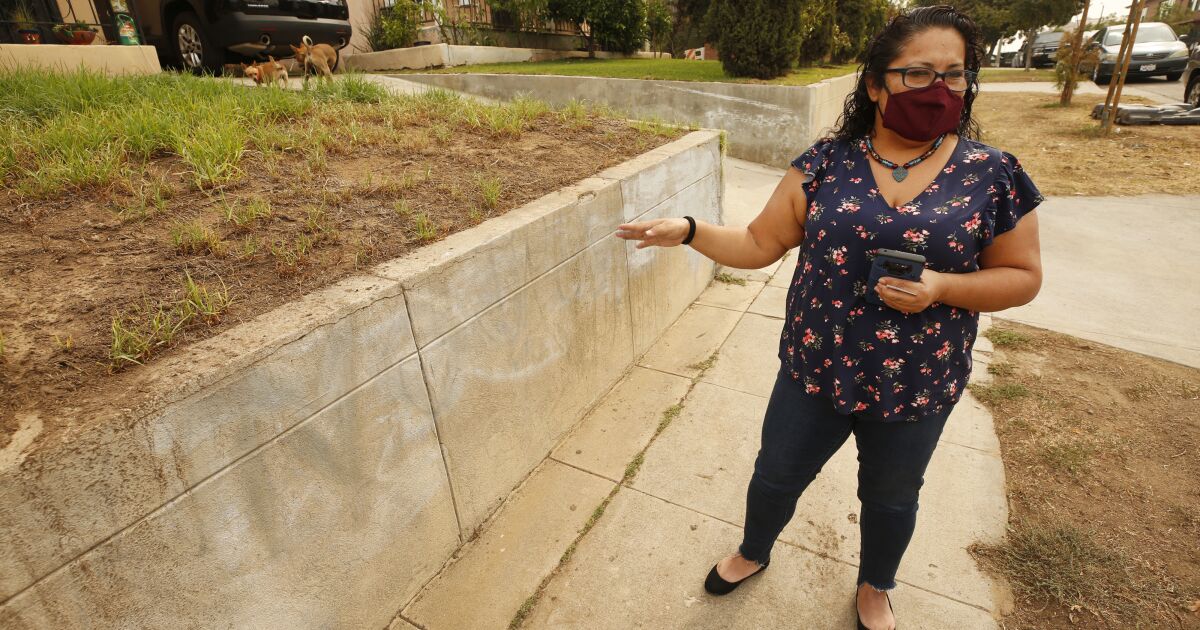As congressional officials urge federal officials to help struggling California’s $750 million effort to remove brain-damaging lead from neighborhoods surrounding the closed Exide battery recycling plant, the Times has learned that the agency in charge of the project had lost millions of dollars earmarked for cleaning up heavily contaminated boardwalks.
Although state Toxics Control Department officials have long insisted they lacked funds to clean up state-owned strips of grass between streets and sidewalks, state lawmakers State had earmarked $6.5 million for testing and cleaning up parkways, according to state finance. department. However, more than half of that money was returned to the general fund after the agency missed a spending deadline, the office said.
News of the loss of funding angered Assembly members who worked to secure funding for the six-year effort. It also sparked outrage among residents of affected neighborhoods in southeast Los Angeles County.
“Money was no problem for the cleanup,” said Mark! Lopez, a community organizer with East Yard Communities for Environmental Justice. “Mismanagement was the main problem. There has been a culture of mismanagement.
A recent Times investigation found that many homes targeted for cleaning ended up with lead levels exceeding state health standards. Some residents and officials say the high concentrations raise serious questions about the department’s oversight of the project — as well as its commitment to protecting predominantly Latino and historically underserved neighborhoods from the potent neurotoxin.
Recently, those concerns prompted Rep. Robert Garcia (D-Long Beach) and the Senses. Dianne Feinstein and Alex Padilla of California to ask the Federal Environmental Protection Agency to intervene.
“We believe the severity of the crisis, the failure of past remediation efforts to create healthy communities, and the risk to public health necessitate the assistance of the EPA and the resources available through the Superfund program,” wrote the lawmakers.
The environmental cleanup — the largest and most expensive in California history — aimed to extract polluted soil from the yards of homes, schools and parks within 1.7 miles of the Exide facility.
However, the Toxic Substances Control Department had no plans to remove the leaded flooring from neighborhood walkways, which are directly in front of most properties.
Of the $6.5 million lawmakers appropriated in 2018 for testing and cleaning up boardwalks, the department used $2.9 million to pay for the collection and testing of more than 8,100 soil samples. , said spokeswoman Allison Westcott.
The analysis revealed that 76% of the samples contained lead levels above the state health limit. The Toxics Control Department estimated it would cost $70 million to clean up the boardwalks in the sanitation area, according to Westcott.
After the tests, the remaining funds were supposed to be spent cleaning up the boardwalks with the highest lead levels and highest exposure risks, according to the ministry’s website. But the agency never devised a plan to clean up the boardwalks and spent none of the remaining $3.6 million over the two-year period. Instead, those funds were returned to the state’s general fund and earmarked for the statewide COVID-19 response after June 2020, state officials said.
Since then, $332 million has been allocated to clean up properties in the area, “more than just restoring that funding,” Westcott said. However, none of this has funded the removal of toxins from the walks.
“DTSC is seeking federal funding by requesting that the cleanup be added to the Superfund list, which could be used to address walks,” she said.
However, conservationists and residents fear that if a federal agency oversees some aspect of the cleanup, it could choose to dispose of lead-contaminated soil above the federal standard, which is five times the standard. California limit.
The Toxic Substances Control Department previously said it had no plans to clean the boardwalks in part “because it was understood that residents generally spend little time in these spaces”.
The department did, however, acknowledge the presence of “high lead levels” and the fact that “simply crossing the boardwalk before entering the house could reintroduce groundbound lead into a home”.
The agency conducted its own survey and found that more than 30% of residents with children said the children played or came into contact with a boardwalk at least once a week, and nearly 10% said the children did it every day.
On Olympic Boulevard in Boyle Heights, a 1,700-foot stretch between Camulos Street and Grand Vista Avenue, a number of boardwalks border the Lou Costello Jr. Recreation Center and Wyvernwood Garden Apartments. State-ordered tests found 12 soil samples from walks in that stretch with lead levels above 1,000 parts per million. The highest, 2,460 parts per million, was collected on a strip of grassy dirt a few feet from the bleachers and a baseball field.
LA County Supervisor Hilda Solis, who lobbied for parkways to be cleaned with homes, said she fears the state’s cleanup approach has allowed contamination to spread from walkways to residential yards – or even inside homes.
Solis, along with Los Angeles County Supervisor Janice Hahn, introduced a resolution calling on the state to identify funds to clean up walkways and said those that are dirty should be cordoned off in the meantime.
“I never thought it made sense not to clean the walks,” Hahn said in a statement. “I always heard it was a funding issue, but now we heard they had the money but didn’t use it in a timely manner. It’s a shame, because what’s at stake here is the health of children and entire families in these neighborhoods.
His comments were echoed by Assemblywoman Wendy Carrillo (D-Los Angeles), who advocated for state funding to test and clean up boardwalks near Exide’s factory.
“Marginalized, low-income, immigrant and non-English speaking communities impacted by the greatest environmental disaster in California history deserve the same scrutiny as wealthier communities experiencing environmental damage,” Carrillo said. “DTSC will have to respond at the Assembly budget hearing on April 19.”
Assemblyman Miguel Santiago (D-Los Angeles), another supporter of the boardwalk’s funding, expressed frustration with past funding.
“We fought hard and allocated $6.5 million to test and clean the boardwalks,” Santiago said in a statement. “Anything less is unacceptable.
At a community meeting last week at the USC Health Sciences Campus in Boyle Heights, residents reviewed new research showing that properties that had been cleaned up by the state still contained high levels of lead. . Many expressed concerns about the project, including the decision to omit the lead cleanup rides.
Jose Gonzalez, a 67-year-old Boyle Heights resident, requested that a federal agency, such as the EPA or the Army Corps of Engineers, take over lead remediation.
Gonzalez worked as a mail carrier for the U.S. Postal Service for about 40 years, roaming the neighborhood boardwalks.
“When you park your car, where is the first place your wife and children walk?” González said. “They step on this stuff, they go inside, they stalk it on the carpet – instant contamination.”
During the meeting, Diego Janacua bounced his 9-month-old daughter on his shoulder as he and his wife, Yvette Aragon-Janacua, listened intently to talk about the extent of lead contamination in the area.
The couple bought a duplex in unincorporated East Los Angeles in March 2022, ignoring lead pollution and state cleanup. Shortly after placing the money in escrow to buy the house, their tenant asked if they knew about the industrial contamination.
The couple, who moved from South Pasadena, said they were stunned.
“Nobody told us about it,” Aragon-Janacua said. “There was no disclosure that you were buying from a place that was contaminated and had hazardous waste. I was pregnant with our firstborn, and I’m horrified that she could have been exposed to this. Where was the transparency? Where was the disclaimer? »
“We got the buyer’s regret instantly,” Janacua added.
The couple said they contacted the Toxic Substances Control Department last summer to request that the soil in their home be tested.
The department said the house should be sampled next month.
“We thought we were doing this big thing, and it became a nightmare,” Aragon-Janacua said. “Now we are considering moving, as I am not going to expose our child to this. Honestly, this gives me major anxiety.
Los Angeles Times
Don’t miss interesting posts on Famousbio










